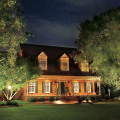Although if you run cables over longer distances or add more lights. Landscape wiring or low voltage electrical cable comes in various calibers or numerical sizes. A lower number means a thicker cable and a greater ability to carry electrical current over longer distances. Common cables for garden lighting are 10, 12, 14 or 16 gauge wires.
We recommend 12 gauge or 10 gauge cables for long distances. This is to prevent voltage drop. The further you move away from the transformer and its power supply, the more resistance is produced in the circuit, causing the voltage to drop. We are about to pour concrete over most of our backyard and we want to bury a low voltage cable for future landscape lights before the pour.
Is there a downside to using a 12 gauge wire instead of a 14 gauge wire? If you're ready to show off even after the sun has gone down, then you'll have DIY landscape lighting in your future. Some other things to consider when choosing LED landscape lights are brightness and color or color temperature. Planning will help you choose the landscape lights, as well as the correct transformer, cable and accessories needed for your particular installation. Your outdoor lighting cable will affect the distance the cable can pass and the number of lights you can add without any voltage drop.
In order to be fully prepared to install a LED garden lighting system, you will need to know how to plan it. It's marginal, but when it comes to landscape lighting over longer distances, it can have an impact. Designing an installation plan for a low-voltage garden lighting system is quite simple, but it's helpful to know a few things right from the start. While most people spend a lot of time planning what lights they are going to add to their landscape setup and carefully selecting the right transformer, it's essential not to overlook the choice of cable.
With the knowledge that thicker cables can work longer, it is good to understand what the range of garden lighting cables tends to cover. No matter how big the planned landscape lighting installation is, you probably need to think carefully about how you are going to connect it all. As I grew older, my interest grew too much in lighting design and how light impacts everything around us. This means that since each light receives slightly less than the previous one, the lights may appear dimmer towards the end of a series.
If you use this method, keep in mind that the polarity of the cable must be maintained from light to light and to the transformer. Most landscape lighting designers begin their design by creating a rough sketch of the property, marking where each fixture will be placed.






